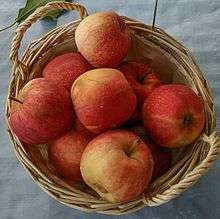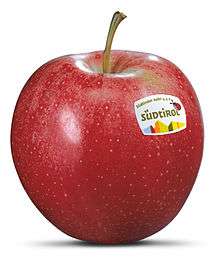Gala (apple)
| Malus pumila 'Gala' | |
|---|---|
 | |
| Species | Malus pumila |
| Hybrid parentage | 'Kidd's Orange Red' × 'Golden Delicious' |
| Cultivar | Gala |
| Origin |
|
.jpg)
Gala is a clonally propagated apple cultivar with a mild and sweet flavor. Gala apples ranked at number 2 in 2006 on the US Apple Association's list of most popular apples, after Red Delicious and before Golden Delicious, Granny Smith, and Fuji (in order).[2] The skin color of the fruit is non-uniform.
Recently, The US Apple Association has projected that the Gala apple will become America's favorite apple. The Granny Smith, Fuji, and Honeycrisp apples are expected to rank third, fourth and fifth, respectively.
Appearance and flavor
Gala apples are vertically striped or mottled, overall orange in color.[1] They are sweet, fine textured, and aromatic,[1] can be added to salads, cooked, or eaten raw, and are especially suitable for creating sauces.[3]
History
The first Gala apple tree was one of many seedlings resulting from a cross between a Golden Delicious and a Kidd's Orange Red planted in New Zealand in the 1930s by orchardist J.H. Kidd. Donald W. McKenzie, an employee of Stark Bros Nursery, obtained a US plant patent for the cultivar on October 15, 1974.[4] It is a relatively new introduction to the UK, first planted in commercial volumes during the 1980s. The variety now represents about 20% of the total volume of the commercial production of eating apples grown in the UK, often replacing Cox's Orange Pippin.
Sports (mutations)
Many sports of Gala have been selected, mostly for increased red color, including the popular Royal Gala. The original cultivar produced fruit with orange stripes and a partial orange blush over a yellow background. Since then, several un-patented sports have been recognized. Additionally, more than twenty sports have received US plant patents:
| Date | "Inventor" | Marketed as | Mutated From | Assignee | Habit | Pattern | Earlier | Color | Plant Patent Number |
|---|---|---|---|---|---|---|---|---|---|
| Oct 15, 1974 | McKenzie | Gala | – | Stark | standard | partial blush | – | yellow | US plant patent 3637 |
| Oct 4, 1977 | Ten Hove | Royal Gala, Tenroy | Gala3637 | Stark | standard | stripe | – | red | US plant patent 4121 |
| May 10, 1988 | Creech | Scarlet Gala[5] | Kidd's D-83637 | C & 0 | standard | blush | – | scarlet | US plant patent 6172 |
| Aug 1, 1989 | Kiddle | Galaxy | Tenroy4121 | Stark | standard | stripe | earlier | intense red | US plant patent 6955 |
| Dec 18, 1990 | Cooper | Treco Spur Red Gala No. 42, Regal | Auvil | Oregon Rootstock | spur | stripe | – | red | US plant patent 7396 |
| Jul 16, 1991 | Fulford | Fulford | Kidd3637 | standard | blush | – | bright red | US plant patent 7589 | |
| Mar 1, 1994 | Olsen | Obrogala, UltraRed | Tenroy4121 | Stark | standard | stripe | 2–4 days | redder | US plant patent 8621 |
| Apr 5, 1994 | Waliser | Waliser Gala | Tenroy4121 | Waliser | standard | stripe | 10 days | bright red | US plant patent 8673 |
| May 10, 1994 | Hill | Applewaites | Kidd's3637 | standard | blush | 2–3 days | more complete red | US plant patent 8720 | |
| Nov 5, 1996 | Olsen | Olsentwo Gala, Pacific Gala | Royal Gala4121 | standard | stripe | 5–10 days | distinguishably different | US plant patent 9681 | |
| Sep 2, 1997 | Brookfield | Baigent | Royal Gala4121 | Brookfield | standard | stripe | extremely early | bright red | US plant patent 10016 |
| Nov 11, 1997 | Gale | Gale Gala | Royal Gala4121 | Van Well | standard | stripe | 3 weeks | more complete | US plant patent 10114 |
| Jun 23, 1998 | Fackler | Big Red Gala | Kidd's3637 | Protree | standard | stripe | – | same | US plant patent 10458 |
| Mar 30, 1999 | Simmons | Simmons | Imperial | Peace Valley | standard | stripe | 21 days | brighter red | US plant patent 10840 |
| Jan 18, 2000 | Stiekema | Stiekema 1 | Obragala8621 | standard | blush | – | red | US plant patent 11182 | |
| Apr 11, 2000 | McSpadden, Jr | Caitlin | Tenroy4121 | Stark | standard | stripe | "earlier" | – | US plant patent 11348 |
| Aug 13, 2002 | Black | Harry Black | Kidd's3637 | International Plant Management | standard | stripe | 5 wk. later | – | US plant patent 12842 |
| Apr 29, 2003 | Banning | Banning Gala | Imperial | standard | stripe | – | intense red blush, darker stripe | US plant patent 13753 | |
| Jan 6, 2004 | Smith | Smith gala | Tenroy4121 | standard | stripe | – | yellow | US plant patent 14448 | |
| May 4, 2004 | Weaver | Weaver | Fulford7589 | Adams County Nursery | more compact | blush | – | bright red | US plant patent 14752 |
| Jan 4, 2005 | Ligonniere | Dalitoga | Imperial | SNC Elaris | standard | stripe | 3 wk. | yellow | US plant patent 15465 |
| Aug 15, 2006 | Burkitt | Burkitt Gala | Tenroy4121 | BMA Trust | standard | stripe | 10 d. | completely red | US plant patent 17013 |
| Feb 26, 2008 | McDonald | El Niño | Royal4121 | standard | intense dark red stripe | bright red | US plant patent 18512 | ||
| Jul 8, 2008 | McLaughlin | McLaughlin Gala, Blondee | Kidd's3637 | standard | no striping or blush | 4—6 d. | yellow | US plant patent 19007 | |
| Dec 30, 2008 | Fankhauser | Alvnia | Gala | Fankhauser | standard | stripes | "earlier" | red, > 95A% coverage | US plant patent 19604 |
| Apr 14, 2009 | Richard | Galaval | Galaxy6955 | Pepinieres du Valois | standard | blush | – | intense dark purple brown | US plant patent 19909 |
Unpatented varieties include: Auvil, Imperial
Descendent cultivar(s)
- Delfloga (Royal Gala × Florina)
- Jazz (Royal Gala × Braeburn)
- Envy (Royal Gala × Braeburn)
- Nicoter (Kanzi) (Gala × Braeburn) [6]
- Sciros (Pacific Rose) (Splendor × Gala)[7]
- Sweetie ('PremA280')
Season

Gala apples are grown from May through September in the northern hemisphere, but, like most apples, are available almost all year through the use of cold storage and controlled atmosphere storage. Australian Gala are available from late January. California fruit is available until October. While the season usually lasts only 9 or 10 months, they are able to last all year round. However, due to some apples continuing to be grown in some orchards, and the fact that they can be refrigerated for some months, leads to the availability of the Gala apple year-round in some Australian markets. These usually taste different (slightly less sweet) from those in season. The UK season begins in late summer (August). Storage makes the UK fruit available nearly year-round as with fruit from other origins.
Royal Gala sport
Royal Gala is a Gala sport, patented by Stark in 1977, which produces redder fruits than the original cultivar. It is a pink-red dessert apple and is therefore usually eaten fresh. Royal Galas are usually harvested in early to late February in the southern hemisphere. In New Zealand the pinker original Gala has almost disappeared as a commercial apple in favour of the darker skinned Royal Gala.
Storage
The optimum temperature for storing apples is between −1° and 1 °C (30 to 34 °F), and the optimum relative humidity is 90 to 95%. Ethylene gas can speed ripening and spoilage and reduce firmness of apples, as with many other fruit.[8]
Listeria
In the beginning of 2015, Royal Gala and Granny Smith apples from the United States were identified as the likely cause of a Listeriosis outbreak.[9] Listeria is a bacterium that can cause nausea, vomiting, headaches, neck stiffness, and can be dangerous to people with deficient immune systems.
Footnotes
- 1 2 3 "Gala", National Fruit Collection, retrieved 31 October 2015
- ↑ Core Facts U.S. Apple Association.
- ↑ http://www.aussieapples.com.au/aussie-grown-varieties/royal-gala.aspx
- ↑ US plant patent 3637
- ↑ US plant patent 7396
- ↑ United States Patent PP17201
- ↑ Ltd, Orange Pippin. "Apple - Pacific Rose™ - tasting notes, identification, reviews". Orange Pippin - all about apples and orchards. Retrieved 16 February 2018.
- ↑ Elizabeth J. Mitcham, Carlos H. Crisosto and Adel A. Kader. "Recommendations for Maintaining Postharvest Quality". Postharvest Technology Research Information Center. Archived from the original on 2010-06-10. Retrieved 2010-10-08.
- ↑ Multistate Outbreak of Listeriosis Linked to Commercially Produced, Prepackaged Caramel Apples Made from Bidart Bros. Apples (Final Update), Centers for Disease Control and Prevention, retrieved 31 October 2015
External links
| Wikimedia Commons has media related to Gala (apple). |
